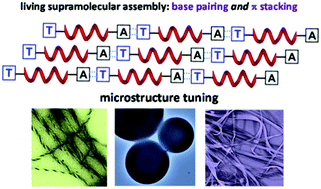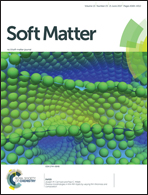Tuning morphological architectures generated through living supramolecular assembly of a helical foldamer end-capped with two complementary nucleobases†
Abstract
Two appropriately functionalized nucleobases, thymine and adenine, have been covalently linked at the N- and C-termini, respectively, of two α-aminoisobutyric acid-rich helical peptide foldamers, aiming at driving self-assembly through complementary recognition. A crystal-state analysis (by X-ray diffraction) on the shorter, achiral foldamer 1 unambiguously shows that adenine⋯thymine base pairing, through Watson–Crick intermolecular H-bonding, does take place between either end of each peptide molecule. In the crystals, π-stacking between base pairs is also observed. Evidence for time-dependent foldamer⋯oldamer associations for the longer, chiral foldamer 2 in solution is provided by circular dichroism measurements. The self-assembly of foldamer 2, through living supramolecular polymerization, eventually leads to the formation of twisted fibers. Such a supramolecular organization can be affected by addition of either pristine adenine or thymine, that acts as a “terminator” by selectively matching a pairing nucleobase at one end of the foldamer. The co-assembly of foldamer 2 with a porphyrin-derivatized thymine, under appropriate experimental conditions, leads to the formation of vesicles which, in turn, can be converted to the fiber morphology by changing the environmental polarity. Conversely, dendrimeric, star polymer-like microstructures are generated when the supramolecular assembly of foldamer 2 is seeded by adenine-capped gold nanoparticles.



 Please wait while we load your content...
Please wait while we load your content...